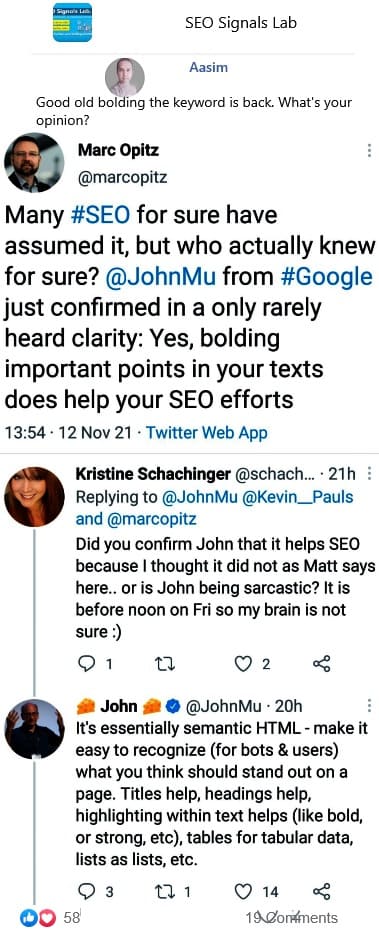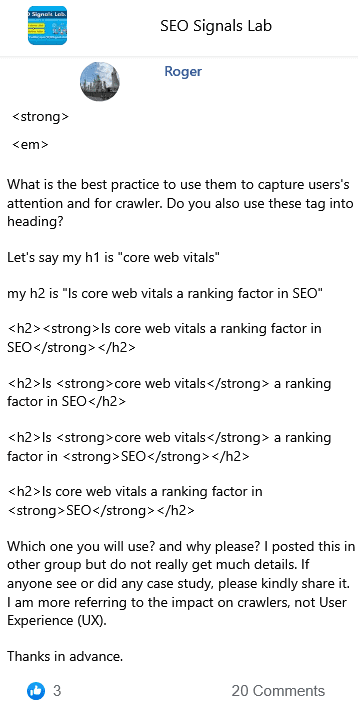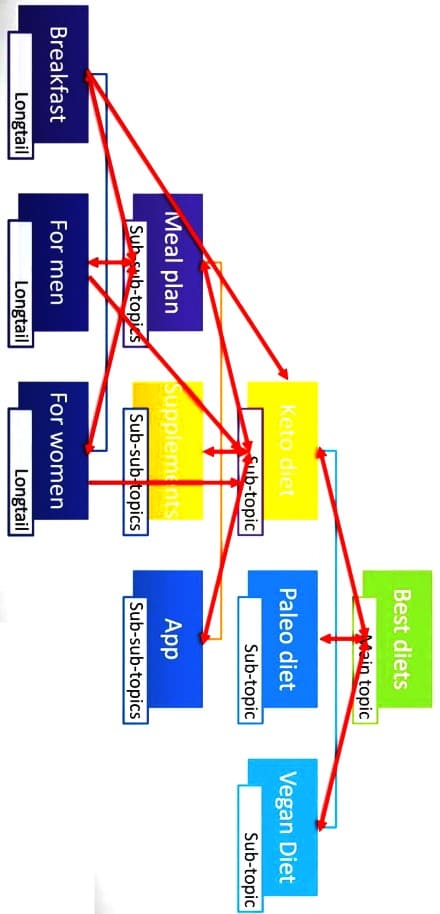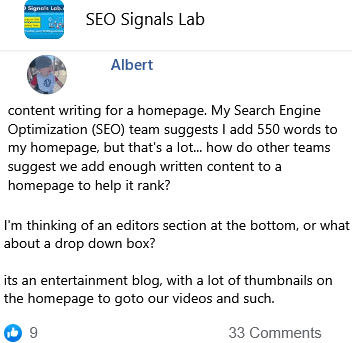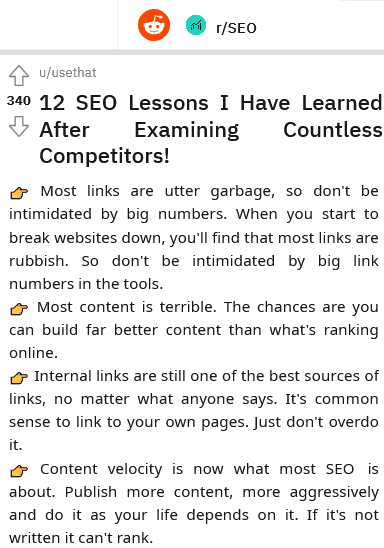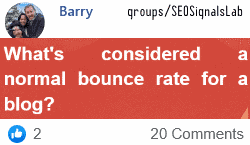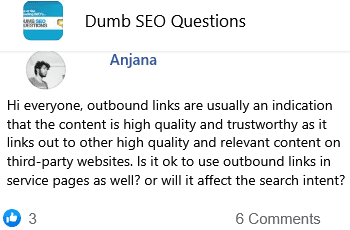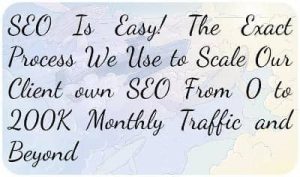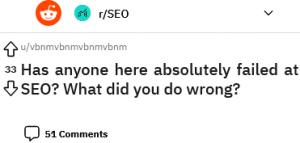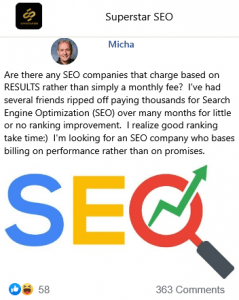Aasim
Good old bolding the keyword is back. What's your opinion?
51 👍🏽5 💟5819 💬🗨
📰👈
It's always been a thing. <strong> and <em> have never stopped being important to do – unless you do it wrong. For example, if you put an entire paragraph inside a <strong> to make it stand out – then just what are you saying is the important entity there?
All semantic and structural html elements can help.
People often tell me that Accessibility and SEO have nothing to do with each other – but those people are wrong, actually. If you think about it – accessibility and SEO go hand in hand.
Our objective with accessibility features is to help machines understand the purpose and functions on the page. The idea is so that alternate methods of accessing that data such as screen readers, tab or voice page and site navigation, skipping parts and generally understanding "what" everything on the page represents so that it can be presented properly. We are attempting to make it so machines can understand what we're saying on each part of the page.
Now… here's the shocker, for some… that's exactly what we're trying to do for Search Engine Optimization (SEO), too – make it so the Big Goo Machine can understand what we're saying on each part of the page.
Take a look at this post on ARIA labels for Accessibility:
https://developer.mozilla.org/en-US/docs/Web/Accessibility/ARIA/RolesTake a look at the "Document Structure Roles" (including the "Semantic HTML part which shows the proper semantic HTML to use instead of ARIA roles). Then go back to Mr. Mueller's post in the screenshot above and notice that he's mentioning a lot of these. Headings, bold, tables, lists, etc.
If used properly and consistently on your site – Google can (and will) take advantage of almost all of those. Widget, Live Region, and Window roles don't help much because they don't indicate things that are useful for ranking, I suppose – but the landmark roles definitely do.
One cool thing here is that since tables, depending upon their content volume, may not work particularly well on mobile devices, you can use "DIV" with the display:table/cell/etc and ARIA roles to transmit that same a formatted table would.
When you hear people say "Structured Data" – it is common to think of schema – which is, of course, structured data. But all this semantic markup, labeling, and yes – even <strong> and <em> tags – they're all structured data. They mean something. (PRO TIP: <b> and <i> are visual elements – they do not indicate importance – they just make it visually stand out – if you want "the machines" to know it's important, you should be using <strong> and <em> – and then only use it for the important things – not large swaths of content which, in essence, makes it so nothing stands out because you're trying to say that everything should stand out.)
When you hear people say, "The theme you choose is important," we often think – ah yeah, because of clean code and page speed. But it's not just speed and cleanliness, it's structural elements and labels within the framework that are important. Here's one quick tip on that. If you go to a theme demo and load a page and then hit the TAB key – if a little box that says "Skip to Content" doesn't appear – move along. The theme's structured data sucks. Now, just because it has that it doesn't necessarily mean that it's all good – but that's a quick, easy way to test and see if the theme creator has at least made an effort to structure things.
💟👍🏽22
Such a lovely comment. ❤️
Leon
Isolated by itself it fares no better/worse than having the keyword in most other tags. In combination with the keyword placed in other tags though- much bigger impact. The key takeaway from John's statement is to create diversity within the html of the page for your keyword
Friar
When was this ever in question? In Search Engine Optimization (SEO) we argue about pretty much everything, but I have never heard anyone debate this.
Trust me. People have argued back and forth over the use of bold as an on-page signal for many years. It's always been one. Never went away. But some people have insisted for years it's never been used.
Rienzi
I still use b and strong tags even in headings.hmmm
You CAN use them in headings. <b> would be used to just make a visual impact (assuming that your heading tags aren't ALREADY bold) and would emphasize the words for Google.
<h1>Widgets.com makes the best Dynamic Widgets</h1>
Perfectly acceptable and valid.
Vladimir
Don't just bold the keywords. Bold sentences or paragraphs where the keywords are.
🤭2
Technically, the less bolding you use, the stronger the effect on what you do, as it is more unique, more special.
It's a bit like back in the early days when SEO users were first talking about how a H1 carried extra weight, so some numpties used Cascading Style Sheets (CSS) to make all H1 text look and behave like paragraph text, wrapping the entire content in H1s … which mean now NOTHING stood out or had weight, because it was all the same.
📰👈
The Summary of Discussion 1: Placing Normal Styled Keyword between the HTML tag Strong or Bold Gets More SEO in Positive
Roger
<strong> <em>
What is the best practice to use them to capture users's attention and for crawler. Do you also use these tag into heading?
Let's say my h1 is "core web vitals"
my h2 is "Is core web vitals a ranking factor in SEO"
<h2>Is core web vitals a ranking factor in SEO</h2>
<h2>Is core web vitals a ranking factor in SEO</h2>
<h2>Is core web vitals a ranking factor in SEO</h2>
<h2>Is core web vitals a ranking factor in SEO</h2>
Which one you will use? and why please? I posted this in other group but do not really get much details. If anyone see or did any case study, please kindly share it. I am more referring to the impact on crawlers, not User Experience (UX).
Thanks in advance.
3 👍🏽320 💬🗨
📰👈
No impact
on crawlers?
KF Ng
Crawlers don't really care those markups though. Importantly it is the context and header tags. Whether you bold the text, it is still h2.
Roger ✍️ » KF Ng
Thanks for taking time to reply. If you found any case study, please kindly share.
Crawlers, i focus more on semantic tags and one of my editor raise this question to me, i can't answer it and suspect may have minor impact or maybe i am over thinking. This one, very hard to do an "apple to apple" test even i edit one of the top ranked page to test because there are still many other ranking signals that contribute to the page.
Sometimes the info we found from the Google SERP is not 100% accurate. For example, 301 vs 307. People claimed that 307 is temporaly and will not pass pagerank but the latest test that i did is 307 did pass pagerank. Google transfer almost all ranking within 72 hours
Another fact that i discover is expired domain page rank reset. Not all expired domain have such scenario. I did few tests, one in the previous few month. I installed WordPress on an expired domain ( offline for more than a year ), no contact us page, no privacy page, no text, no logo, no plugin, no content. The whole site just one page, the homepage with 2 words – coming soon. I do not manual index. 48 hours later, GSC show me many buyer intent keywords
Latest test is 2 weeks ago. I created a page with 1000 words, talk about domain ( my site do not have any post in this cluster, this is first ). The page do not fully optimized for Search Engine Optimization (SEO). I redirect 16 domains ( no tropical relevance at all, travel niche, forex niche, clothes niche, random niche ) toward this page and i immediately see good signals in Google Search Console (GSC)
KF Ng
I wish got a case study on those strong and em tags. but really, no clients in the past actually done this study cos in markup header tags like h2 h3 just a markup to say this is important. I don't see in Google guideline or in forums saying strong tags means important…
Stojan » KF Ng
<em> is quite important as far as i know for audio optimization. <strong> also can help.
Mike
These tags carry strong semantics, so you better study html5 standard documentation on what they mean
but there is no point adding strong tags while using header tags? header tags already normally bold and has already strong signal it is a section title. adding another strong tag doesn't do anything for h2 imho. I mean it is not even common use and well verse researched.
https://webmasters.stackexchange.com/questions/76606/does-bold-text-really-improve-your-search-engine-rankingsDoes bold text really improve your search engine rankings?
Mike » KF Ng
Strong is not = bold. Use css styles for the sake or making text bold
KF Ng » Mike
Yes of course for the styling. but header tag is already emphasizing its importance. adding another just overkill imho. it is a p tag then that's fine. Why stress the importance twice since h2 already a strong signal what you are talking about? Never seen an article practices this way to highlight a specific word but it is good to point out structurely it is not a good practice for header tags
Roger ✍️
Benson Woo for ux, bold work like a charm if do it right. Right now majority of people use mobile (also depend on niche) and bold make the content look good, more scrolls, more activities, more positive ux signals. Lets say this h2
Core web vitals increased 142% traffic in Search Engine Optimization (SEO)
What if i hightlight 142%? It look more attractive to audience. Off course i can use span instead of bold. I am wondering is it bold inside heading will give Google crawlers any positive signal or not or the opposite.
📰👈
Truslow 🎓
The h tags along with <strong> and <em> are designed to bring emphasis to things – but in different ways.
<strong> and <em> give import to the words themselves.
<hx> tags give import to the words inside, but in specific relation to the words in the section that follows. If the words within the section that your thing is a heading for don't clarify, explain, describe, disambiguate, or otherwise give meaning to the heading – the heading really has no value.
Now… Google is pretty smart and if you do these things properly (and most importantly, consistently) – it can benefit you. It you aren't doing it properly and/or consistently, then it's not really going to hurt things (i.e. there's no negative impact beyond the loss of positive impact).
Putting a <strong> inside a heading – not the entire heading (that would be redundant) – might just maybe possibly send a signal that the words in the strong tag are the ones that are of most import within the statement the heading is making. I would imagine that if it did manage to evolve into a signal Google could use – it would have to be done with consistency across the site and various Natural Language Processing (NLP) extractions (and maybe other things) would have to validate that those are, in fact, the most important words in there.
When considering a concept like this, I always look at it this way… Does it makes sense and follow the standards that the tags were designed for? Is there something that could be gained and is it something that I can do with consistency so that the signals are clear and focused – both for the users and a machine that might be trying to interpret what you do. And then finally – can it be done in an efficient and scalable way that won't cost more to execute, maintain, and continue than it could ever hope to generate in benefit for the site?
If you can answer yes to those things (and you can answer yes to the "meets standards" part of it) then it might be worth trying. I wouldn't go doing it on every client's site until I saw whether it worked or not – but it's a low risk thing so… maybe.
Of your 4 choices at the top, I would personally go to the third one. You've emphasized both entities in the title and given them a relationship with the words in between. That's what we call a Semantic Triple. <core web vitals> <is a ranking factor in> <SEO>. Typically we try to do that with our copy all the time and let it get picked up naturally, but if you're doing it right, I don't see a major risk in giving that triple some structure (the strong tags) to help signal that it's what you're trying to get across. Structure when used consistently and accurately so the same signal is being sent every time does nothing but help SEO.
But remember – it's not just the mere act of adding the <strong> to your headings that is helping. It's the value those labels give to structuring the information within and near those tags that is helping (if it helps at all).
Thank you so much! Honest speaking, i am waiting for your reply here. I saw your replies on other threads, very informative, on point and you are really good on Natural Language Processing (NLP). It is my honor to have your reply on this thread.
I get what you mean now. Might edit one of my post ( that ranked for year, not designed to attract links )to test the impact of the <strong> in heading for the entities and monitor those queries that belong to those entities. Once again, thank you so much for taking time to clear what i am worry about.
Truslow 🎓
Thanks for the compliments!
On one single page, it won't make much difference. Even on 20% of the pages (unless they are clustered together and even then… I'm not sure) it won't make much difference.
The most important word in my post above is "consistency". Machines are great at picking up patterns and then if those patterns send a signal that can be determined, they can use that.
Changing it on one or just a couple pages does not a pattern make.
Roger ✍️ » Truslow
Noted with thanks. Yes, "consistency" is the key. I guess it will also take time to see the impacts.
Toto
Don't use strong or em in an h tag. If you're using strong you don't need em, if you're using em you don't need strong. Stick with one tag for a piece of text. Learn how to properly use these tags. w3schools.com is a good place to start.W3SCHOOLS.COM
W3Schools Free Online Web Tutorials
Strong is perfectly acceptable within a heading. The specifications from the organization you linked to explicitly says so.
https://www.w3.org/TR/2016/REC-html51-20161101/textlevel-semantics.html#elementdef-strongToto » Truslow
You can do lots of things in HTML that you really shouldn't do.
Truslow 🎓
When the HTML specifications explicitly state that you can and then describes the purpose and function of doing so – you absolutely can. And, in fact, if you are trying to actually do the thing the specification is saying that this is the way to do it – then you absolutely should.
That's really the entire point of the HTML specification.
You may have personal reasons why you don't want to do it, but that doesn't change the fact that it IS acceptable and is the way you can give specific words within a heading emphasis to make them stand out from the other words.
📰👈
Are Keywords You Mean Valuable in Google First Search Result Page?
Does Backlinking From Low-Quality Article But It has Keyword Golden Ratio Still Gives Positive Off-Page SEO?
A Client is Asking for Target Numbers Involving Organic Keywords and Traffic within Few Months
Ammon: Google don’t count Words or Keywords, but they count Page Speed
Does Keyword Difficulty Of Zero Mean It Leads Traffic Near 0 too?
How important is an SEO agency to rank their Agency Site for Main Buyer Intent Keyword?
How do Keyword Planners actually work?
